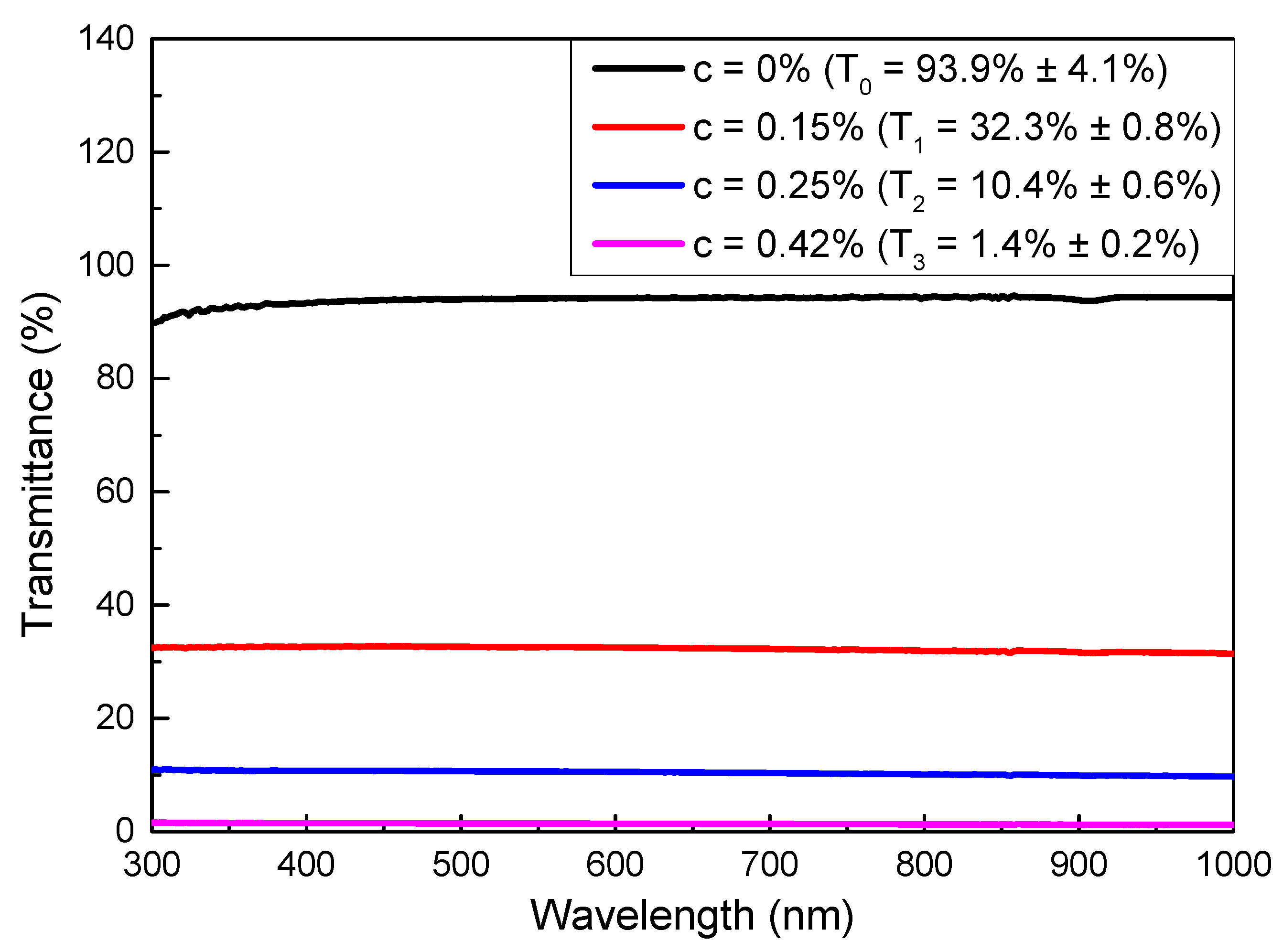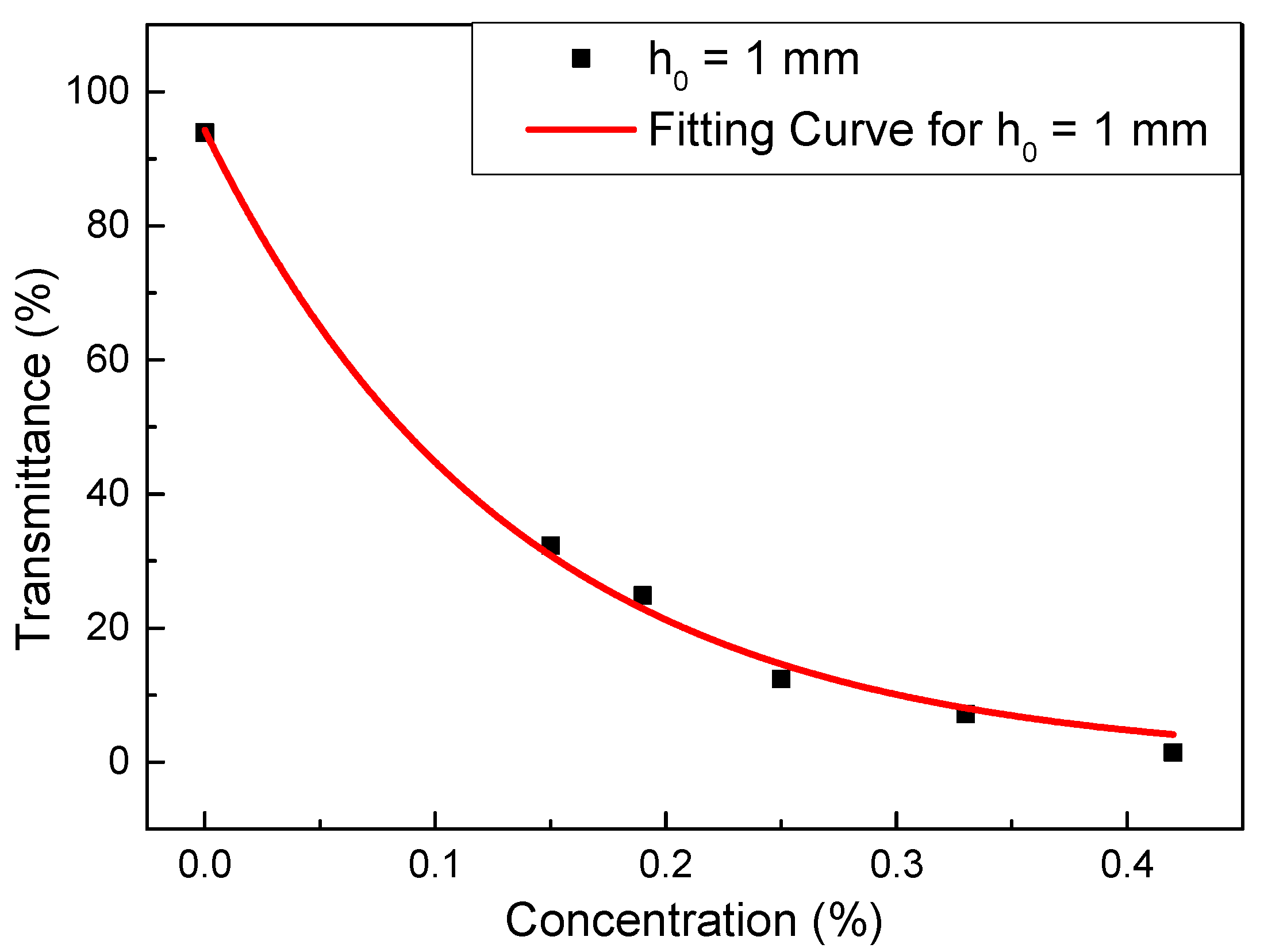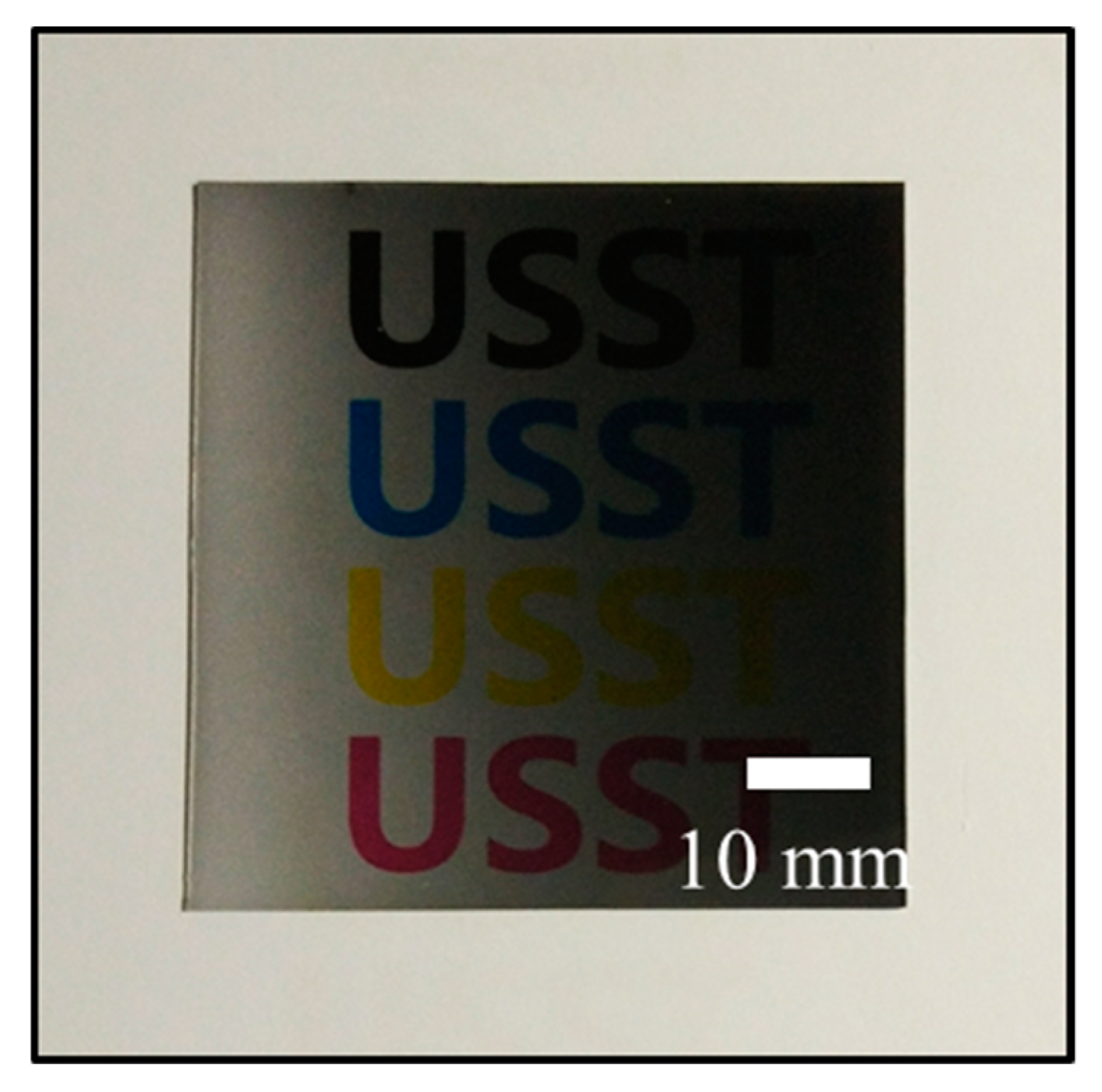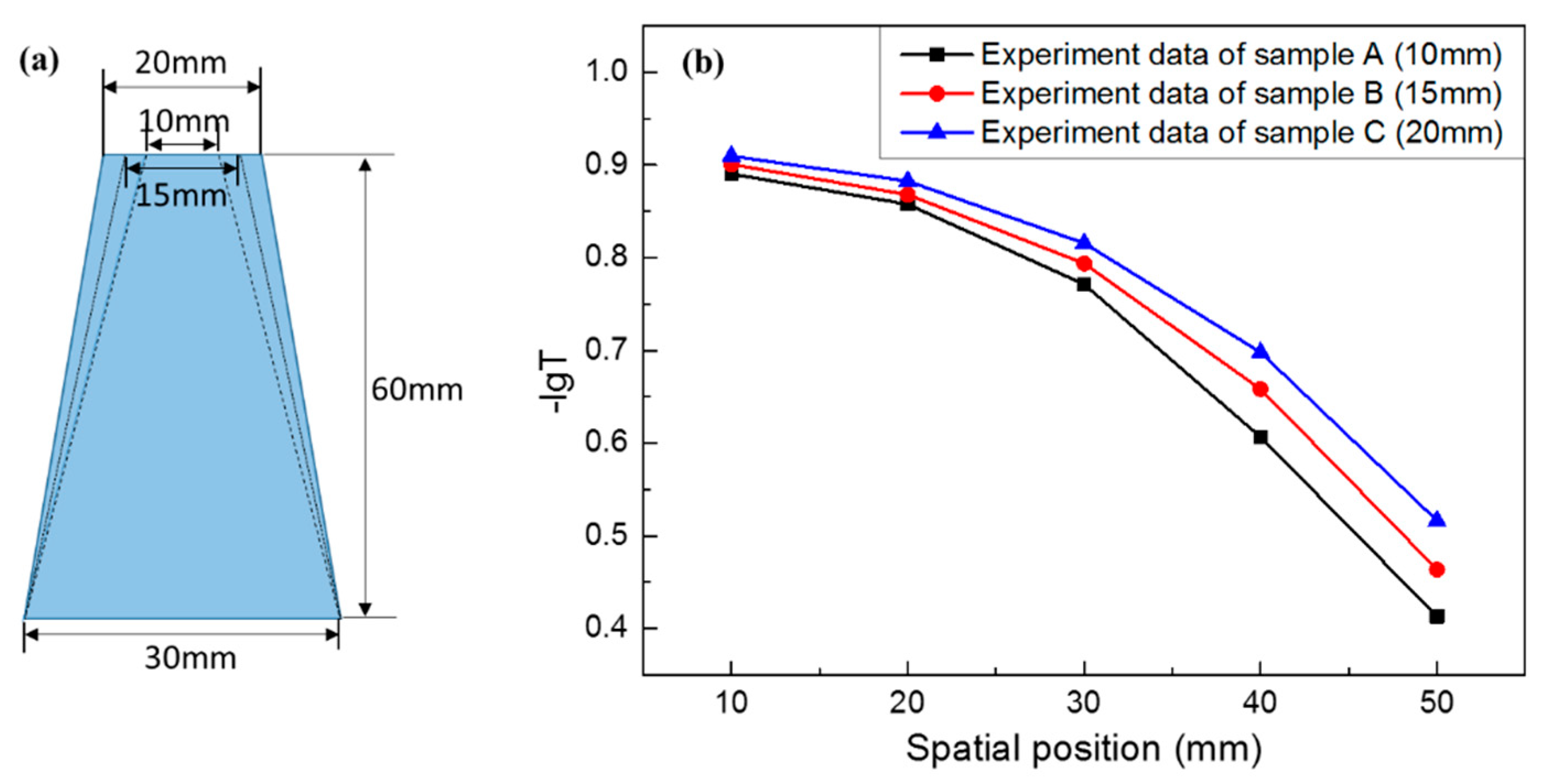Composite Films of Polydimethylsiloxane and Micro-Graphite with Tunable Optical Transmittance
Abstract
1. Introduction
2. Experimental Section
2.1. Materials
2.2. Preparation Routes
2.3. Characterizations
3. Results and Discussion
3.1. Transmittance Characterization for Different Concentrations
3.2. Transmittance Characterization of Wedge-Shaped Specimen
3.3. Mechanical Stretching of Trapezoid-Shaped Composite Films with Uniform Thickness
4. Conclusions
Author Contributions
Funding
Acknowledgments
Conflicts of Interest
References
- Ma, J.; Hu, J.; Li, Z.; Nan, C.W. Recent progress in multiferroic magnetoelectric composites: From bulk to thin films. Adv. Mater. 2011, 23, 1062–1087. [Google Scholar] [CrossRef] [PubMed]
- Qi, L.; Lee, B.I.; Chen, S.H.; Samuels, W.D.; Exarhos, G.J. High-dielectric-constant silver–epoxy composites as embedded dielectrics. Adv. Mater. 2005, 17, 1777–1781. [Google Scholar] [CrossRef]
- Jones, R.M. Mechanics of composite materials, 2nd ed.; Taylor & Francis Group: Abingdon, UK, 1999; pp. 389–400. [Google Scholar]
- Chen, J.; Zheng, J.; Gao, Q.; Zhang, J.; Zhang, J.; Omisore, O.M.; Wang, L.; Li, H. Polydimethylsiloxane (PDMS)-Based Flexible Resistive Strain Sensors for Wearable Applications. Appl. Sci. 2018, 8, 345. [Google Scholar] [CrossRef]
- Gandhi, S.S.; Chien, L.C. High transmittance optical films based on quantum dot composites nanoscale polymer dispersed liquid crystals. Opt. Mater. 2016, 54, 300–305. [Google Scholar] [CrossRef]
- Granqvist, C.G.; Avendaño, E.; Azens, A. Electrochromic coatings and devices: Survey of some recent advances. Thin Solid Films 2003, 442, 201–211. [Google Scholar] [CrossRef]
- Dyer, A.L.; Grenier, C.R.G.; Reynolds, J.R.A. Poly(3,4-alkylenedioxythiophene) Electrochromic Variable Optical Attenuator with Near-Infrared Reflectivity Tuned Independently of the Visible Region. Adv. Funct. Mater. 2007, 17, 1480–1486. [Google Scholar] [CrossRef]
- Sampanthar, J.T.; Neoh, K.G.; Ng, S.W.; Kang, E.T.; Tan, K.L. Flexible Smart Window via Surface Graft Copolymerization of Viologen on Polyethylene. Adv. Mater. 2000, 12, 1536–1539. [Google Scholar] [CrossRef]
- Parkin, I.P.; Manning, T.D. Intelligent Thermochromic Windows. J. Chem. Educ. 2006, 83, 393–400. [Google Scholar] [CrossRef]
- Hoi, S.K.; Chen, X.; Kumar, V.S.; Homhuan, S.; Sow, C.H.; Bettiol, A.A. Microfluidic Chip with Integrated Colloidal Crystal for Online Optical Analysis. Adv. Funct. Mater. 2011, 21, 2847–2853. [Google Scholar] [CrossRef]
- Scaffaro, R.; Maio, A. Influence of Oxidation Level of Graphene Oxide on the Mechanical Performance and Photo-Oxidation Resistance of a Polyamide 6. Polymers 2019, 11, 857. [Google Scholar] [CrossRef]
- Scaffaro, R.; Maio, A. A green method to prepare nanosilica modified graphene oxide to inhibit nanoparticles re-aggregation during melt processing. Chem. Eng. J. 2017, 16, 1034–1047. [Google Scholar] [CrossRef]
- Lee, H.; Low, M.J.; Lim, C.H.J.; An, J.; Sandeep, C.S.; SRohith, T.M.; Rhee, H.; Murukeshan, V.M.; Kim, Y. Transferable ultra-thin multi-level micro-optics patterned by tunable photoreduction and photoablation for hybrid optics. Carbon 2019, 149, 572–581. [Google Scholar] [CrossRef]
- Scaffaro, R.; Maio, A.; Re, G.L.; Parisi, A.; Busacca, A. Advanced piezoresistive sensor achieved by amphiphilic nanointerfaces of graphene oxide and biodegradable polymer blends. Compos. Sci. Technol. 2018, 156, 166–176. [Google Scholar] [CrossRef]
- Zhang, Y.; Lu, Y.; Yan, X.; Gao, W.; Chen, H.; Chen, Q.; Bai, Y.X. Functional & Enhanced Graphene/Polyamide 6 composite fiber Constructed by A Facile and Universal Method. Compos. Part A 2018, 57, 10967–10976. [Google Scholar]
- Wang, W.; Zhang, Y.; Han, B.; Ma, J.; Wang, J.; Han, D.; Ma, Z.; Sun, H. A complementary strategy for producing moisture and alkane dual-responsive actuators based on graphene oxide and PDMS bimorph. Sens. Actuators B 2019, 290, 133–139. [Google Scholar] [CrossRef]
- Wang, Y.; Yang, R.; Shi, Z.; Zhang, L.; Shi, D.; Wang, E.; Zhang, G. Super-Elastic Graphene Ripples for Flexible Strain Sensors. ACSNANO 2011, 5, 3645–3650. [Google Scholar] [CrossRef]
- Kou, H.; Zhang, L.; Tan, Q.; Liu, G.; Dong, H.; Zhang, W.; Xiong, J. Wireless wide-range pressure sensor based on graphene/PDMs sponge for tactile monitoring. Sci. Rep. 2019, 9, 3916. [Google Scholar] [CrossRef]
- Scaffaro, R.; Maio, A. Integrated ternary bionanocomposites with superior mechanical performance via the synergistic role of graphene and plasma treated carbon nanotubes. Compos. Part B 2019, 168, 550–559. [Google Scholar] [CrossRef]
- Scaffaro, R.; Maio, A.; Lopresti, F. Effect of graphene and fabrication technique on the release kinetics of carvacrol from polylactic acid. Compos. Sci. Technol. 2019, 169, 60–69. [Google Scholar] [CrossRef]
- Baetens, R.; Jelle, B.P.; Gustavsen, A. Properties, requirements and possibilities of smart windows for dynamic daylight and solar energy control in buildings: A state-of-the-art review. Sol. Energy Mater. Sol. Cells 2010, 94, 87–105. [Google Scholar] [CrossRef]
- Molberg, M.; Leterrier, Y.; Plummer, C.J.G.; Walder, C. Frequency dependent dielectric and mechanical behavior of elastomers for actuator applications. J. Appl. Phys. 2009, 106, 054112–054117. [Google Scholar] [CrossRef]
- Sheng, B.; Luo, L.; Huang, Y.; Chen, G.; Zhou, H.; Zhang, D.; Zhuang, S. Tailorable Elastomeric Grating with Tunable Groove Density Gradient. IEEE Photonics J. 2017, 9, 2400406. [Google Scholar] [CrossRef]
- Rosset, S.; Shea, H.R. Flexible and stretchable electrodes for dielectric elastomer actuators. Appl. Phys. A 2013, 110, 281–307. [Google Scholar] [CrossRef]
- Zhang, Y.; Xu, S.; Fu, H.; Lee, J.; Su, J.; Hwang, K.C.; Rogers, J.A.; Huang, Y. Buckling in serpentine microstructures and applications in elastomer-supported ultra-stretchable electronics with high areal coverage. Soft Matter 2013, 9, 8062–8070. [Google Scholar] [CrossRef] [PubMed]
- Adrega, T.; Lacour, S.P. Stretchable gold conductors embedded in PDMS and patterned by photolithography: Fabrication and electromechanical characterization. J. Micromech. Microeng. 2010, 20, 055025. [Google Scholar] [CrossRef]
- Tooley, W.W.; Feghhi, S.; Han, S.J.; Wang, J.; Sniadecki, N.J. Thermal fracture of oxidized polydimethylsiloxane during soft lithography of nanopost arrays. J. Micromech. Microeng. 2011, 21, 54013–54019. [Google Scholar] [CrossRef]
- Xin, Q.B.; Ookawa, K.; Wong, J.Y. Evaluation of polydimethylsiloxane scaffolds with physiologically-relevant elastic moduli: Interplay of substrate mechanics and surface chemistry effects on vascular smooth muscle cell response. Biomaterials 2005, 26, 3123–3129. [Google Scholar]
- López Jiménez, F.; Kumar, S.; Reis, P.M. Soft Color Composites with Tunable Optical Transmittance. Adv. Opt. Mater. 2016, 4, 620–626. [Google Scholar] [CrossRef]
- Minnai, C.; Di, V.M.; Milani, P. Mechanical-optical-electro modulation by stretching a polymer-metal nanocomposite. Nanotechnology 2017, 28, 355702. [Google Scholar] [CrossRef]
- Mohamed-Noriega, N.; Hinojosa, M.; González, V.; Rodil, S.E. Polymer-based composite with outstanding mechanically tunable refractive index. Opt. Mater. 2016, 58, 18–23. [Google Scholar] [CrossRef]
- Apostoleris, H.N.; Chiesa, M.; Stefancich, M. Improved transparency switching in paraffin-PDMS composites. J. Mater. Chem. C 2015, 3, 1371–1377. [Google Scholar] [CrossRef]
- Prasse, T.; Flandin, L.; Schulte, K.; Bauhofer, W. In situ observation of electric field induced agglomeration of carbon black in epoxy resin. Appl. Phys. Lett. 1998, 72, 2903–2905. [Google Scholar] [CrossRef]
- Cooper, C.A.; Ravich, D.; Lips, D.; Mayer, J.; Wagner, H.D. Distribution and alignment of carbon nanotubes and nanofibrils in a polymer matrix. Compos. Sci. Technol. 2002, 62, 1105–1112. [Google Scholar] [CrossRef]
- Schwarz, M.K.; Bauhofer, W.; Schulte, K. Alternating electric field induced agglomeration of carbon black filled resins. Polymer 2002, 43, 3079–3082. [Google Scholar] [CrossRef]
- Ajayan, P.M. Aligned carbon nanotubes in a thin polymer film. Adv. Mater. 1995, 7, 489–491. [Google Scholar] [CrossRef]
- Kimura, T.; Ago, H.; Tobita, M.; Ohshima, S.; Kyotani, M.; Yumura, M. Polymer Composites of Carbon Nanotubes Aligned by a Magnetic Field. Adv. Mater. 2002, 14, 1380–1383. [Google Scholar] [CrossRef]
- Choi, E.S.; Brooks, J.S.; Eaton, D.L.; Al-Haik, M.S. Enhancement of thermal and electrical properties of carbon nanotube polymer composites by magnetic field processing. J. Appl. Phys. 2003, 94, 6034–6039. [Google Scholar] [CrossRef]






© 2019 by the authors. Licensee MDPI, Basel, Switzerland. This article is an open access article distributed under the terms and conditions of the Creative Commons Attribution (CC BY) license (http://creativecommons.org/licenses/by/4.0/).
Share and Cite
Wang, Q.; Sheng, B.; Wu, H.; Huang, Y.; Zhang, D.; Zhuang, S. Composite Films of Polydimethylsiloxane and Micro-Graphite with Tunable Optical Transmittance. Appl. Sci. 2019, 9, 2402. https://doi.org/10.3390/app9122402
Wang Q, Sheng B, Wu H, Huang Y, Zhang D, Zhuang S. Composite Films of Polydimethylsiloxane and Micro-Graphite with Tunable Optical Transmittance. Applied Sciences. 2019; 9(12):2402. https://doi.org/10.3390/app9122402
Chicago/Turabian StyleWang, Qi, Bin Sheng, He Wu, Yuanshen Huang, Dawei Zhang, and Songlin Zhuang. 2019. "Composite Films of Polydimethylsiloxane and Micro-Graphite with Tunable Optical Transmittance" Applied Sciences 9, no. 12: 2402. https://doi.org/10.3390/app9122402
APA StyleWang, Q., Sheng, B., Wu, H., Huang, Y., Zhang, D., & Zhuang, S. (2019). Composite Films of Polydimethylsiloxane and Micro-Graphite with Tunable Optical Transmittance. Applied Sciences, 9(12), 2402. https://doi.org/10.3390/app9122402




